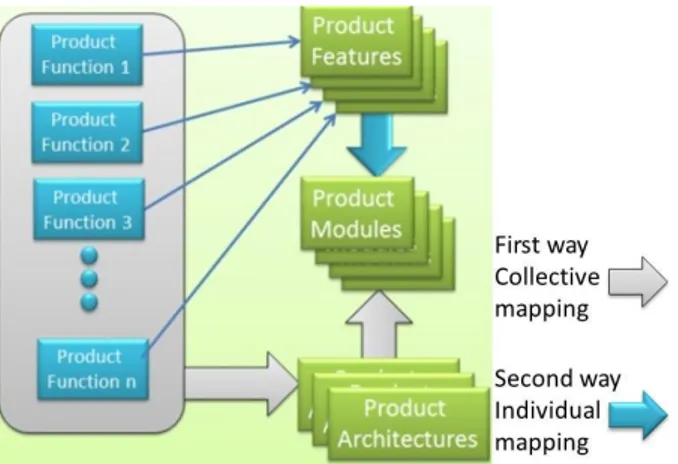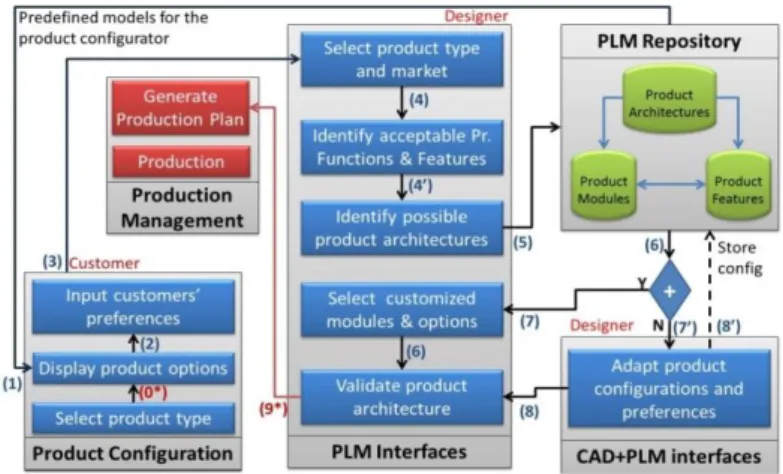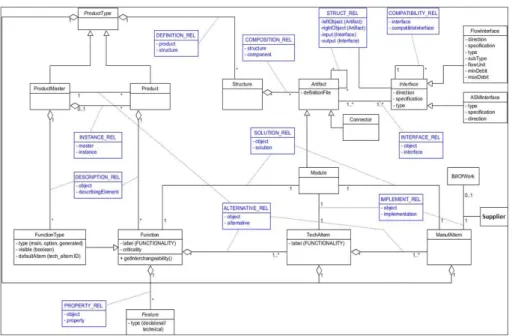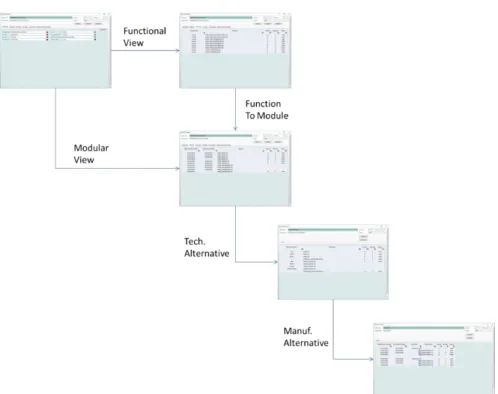HAL Id: hal-01764153
https://hal.inria.fr/hal-01764153
Submitted on 11 Apr 2018
HAL is a multi-disciplinary open access
archive for the deposit and dissemination of
sci-entific research documents, whether they are
pub-lished or not. The documents may come from
teaching and research institutions in France or
abroad, or from public or private research centers.
L’archive ouverte pluridisciplinaire HAL, est
destinée au dépôt et à la diffusion de documents
scientifiques de niveau recherche, publiés ou non,
émanant des établissements d’enseignement et de
recherche français ou étrangers, des laboratoires
publics ou privés.
Distributed under a Creative Commons Attribution| 4.0 International License
Modular Architectures Management with PLM for the
Adaptation of Frugal Products to Regional Markets
Farouk Belkadi, Ravi Gupta, Stéphane Natalizio, Alain Bernard
To cite this version:
Farouk Belkadi, Ravi Gupta, Stéphane Natalizio, Alain Bernard. Modular Architectures
Manage-ment with PLM for the Adaptation of Frugal Products to Regional Markets. 14th IFIP
Interna-tional Conference on Product Lifecycle Management (PLM), Jul 2017, Seville, Spain. pp.462-472,
�10.1007/978-3-319-72905-3_41�. �hal-01764153�
adfa, p. 1, 2011.
© Springer-Verlag Berlin Heidelberg 2011
Modular architectures management with PLM for the
adaptation of frugal products to regional markets
Farouk Belkadi1*, Ravi Kumar Gupta1, Stéphane Natalizio2, Alain Bernard1
1
Ecole Centrale de Nantes – LS2N, UMR CNRS 6597, Nantes – France
2 AUDROS Technology, Lyon – France 1firstname.lastname@ls2n.fr; 2
snatalizio@audros.fr
Abstract. Nowadays companies are challenged with high competitiveness and
saturation of markets leading to a permanent need of innovative products that ensure the leadership of these companies in existing markets and help them to reach new potential markets (i.e. emerging and mature market). Requirements of emerging markets are different in terms of geographic, economic, cultural, governance policies and standards. Thus, adopting existing European product to develop new products tailored to emerging markets is one possible strategy that can help companies to cope with such challenge. To do so, a large variety of products and options have to be created, managed and classified according to the requirements and constraints from a target regional market. This paper dis-cusses the potential of PLM approach to implement the proposed modular product design approach for the adaptation of European product and production facilities to emerging markets. Using modular approach, the product design evolves iteratively coupling the configuration of various alternatives of product architectures and the connection of functional structures to their contexts of use. This enables the customization of adapted product to specific customer’s needs.
Keywords: PLM, Modular Architecture, Product Features, Co-evolution
1 Introduction
Customer’s requirements fluctuate across geographical regions, standards, and con-text of use of the product of interest, whereas global production facilities to address such requirements are constrained by local governing policies, standards, and local resources availability. In order to address emerging market’s needs and adapt existing product development facilities, it is important to analyze and evaluate different possi-bilities of product solutions against specific requirements of one regional market.
An emerging market is generally characterized as a market under development with less presence of standards and policies comparing to mature markets in the de-veloped countries [1]. To respond to the competition from these emerging countries, frugal innovation is considered as a solution to produce customized products in a shorter time for improving the attractiveness of western companies [2]. Frugal inno-vation or frugal engineering is the process of reducing the complexity and cost of goods, and their production. A frugal product is defined in most industries in terms of
the following attributes: Functional, Robust, User-friendly, Growing, Affordable and Local. The details of these attributes are given in [3,4].
As per the study [5], these frugal attributes are not always sufficient for adapting existing product development facilities in European countries to emerging markets. Several additional factors can influence consumer behavior as well such as cultural, social, personal, psychological and so on. To answer this demand, companies have to provide tangible goods and intangible services that result from several processes in-volving human and material resources to provide an added value to the customer.
However, looking to the large variety of markets, customer categories, needs and characteristics, companies have to create and manage a huge variety of products and services, under more complex constraints of delivery time reduction and cost saving. To do so, optimization strategy should concern all steps of the development process, including design, production, packaging and transportation [6].
Generally, three categories of product are distinguished depending on the level of customization and the consideration of customer preferences, namely: (i) standard products that don’t propose any customization facility; (ii) mass customized product offering customization on some parts of the product, and (iii) unique product devel-oped to answer specific customer demand. Despite this variety, every product is de-fined through a bundle of elements and attributes capable of exchange and use. It is often proven that modular architectures offer high advantages to support creation and management of various product architectures from the same family. Taking advantage from this concept, this paper proposes the use of a modular approach to address the emerging market requirements through the adaptation of original products. The key issue is the use of PLM (Product Lifecycle Management) framework as a kernel tool to support both the management of product architectures and the connection of these architectures with production strategies. The specific use case of product configura-tion of mass customized product is considered as applicaconfigura-tion context.
The next section discusses the main foundation of modular approach and its use for the configuration of product architectures. Section 3 discusses the implementation of the proposed approach in Audros software. Audros is a French PLM providing a set of flexible tools adaptable to a lot of functional domains through an intelligent merge of the business process model, the data model generator and the user interface design. Finally, section 4 gives the conclusion and future works.
2
Product configuration strategies within modular approach
2.1 Product modular architecturesProduct architecture is the way by which the functional elements (or functions) of a product are arranged into physical units (components) and the way in which these units interact [7]. The choice of product architecture has broad implications for prod-uct performance, prodprod-uct change, prodprod-uct variety, and manufacturability [8]. Prodprod-uct architecture is thought of in terms of its modules. It is also strongly coupled to the firm's development capability, manufacturing specialties, and production strategy [9].
A product module is a physical or conceptual grouping of product components to form a consistent unit that can be easily identified and replaced in the product archi-tecture. Alternative modules are a group of modules of the same type and satisfy sev-eral reasoning criteria/features for a product function. Modularity is the concept of decomposing a system into independent parts or modules that can be treated as logical units [9,10]. Modular product architecture, sets of modules that are shared among a product family, can bring cost savings and enable the introduction of multiple product variants quicker than without architecture. Several companies have adopted modular thinking or modularity in various industries such as Boeing, Chrysler, Ford, Motorola, Swatch, Microsoft, Conti Tires, etc. [11]. Hubka and Eder [12] define a modular de-sign as “connecting the constructional elements into suitable groups from which many variants of technical systems can be assembled”. Salhieh and Kamrani [13] define a module as “building block that can be grouped with other building blocks to form a variety of products”. They also add that modules perform discrete functions, and modular design emphasizes minimization of interactions between components.
Generic Product Architecture (GPA) is a graph where nodes represent product modules and links represent connections among product modules according to specif-ic interfaces (functional, physspecif-ical, information and material flow) to represent a prod-uct or a set of similar prodprod-ucts forming a prodprod-uct family. A GPA represents the struc-ture of the functional elements and their mapping into different modules and specifies their interfaces. It embodies the configuration mechanism to define the rules of prod-uct variant derivation [14]. A clear definition of the potential offers of the company and the feasibility of product characteristics could be established for a set of require-ments [15]. Figure 1 shows an example of modular product architecture for the case of bobcat machine, including the internal composition of modules and the interaction between them [16]. The similar concepts mentioned in the literature are ‘building product architecture’, ‘design dependencies and interfaces’ and ‘architecture of prod-uct families’, which can be used for the development of GPA. The GPA can be con-structed by using different methods presented in the literature [17,18].
2.2 Construction of modular architectures
The use of the modular approach should propose the facility to work in different con-figurations. The concept of GPA can give interesting advantages for these issues. Indeed, by using existing GPA to extract reusable modules, a first assessment of inter-faces compatibilities and performance of the selected modules can be performed re-garding various product structures. Thus, module features are defined to support these assessments and used to link process specifications, production capabilities, and all other important criteria involved in the product development process. As the devel-oped GPA is a materialization of the existing products, the adaptation of these prod-ucts to the new market requirements will be obtained through some swapping, replac-ing, combining and/or modification actions on the original product architectures.
In fact, the application of customer-driven product-service design can follow one of two ways processes; either collectively through generic product architecture by mapping all the requested functions, or by mapping functions individually through features and then configuring product modules (cf. Figure 2). In this last case, more flexibility is allowed for the selection of products modules and consequently more innovative possibilities for the final product alternatives. However, more attention is required for the global consistency of the whole structure. The concept of “feature” is considered as a generic term that includes technical characteristics used for engineer-ing perspective as well as inputs for decision-makengineer-ing criteria, useful for the deploy-ment of customer-driven design process in the context of adaptation of existing Euro-pean product and development facilities to an emerging market.
Fig. 2. Two ways product configuration strategies for identification of modules for a product
In the first case, starting from existing solutions implies a high level of knowledge about the whole development process and will reduce considerably the cost of adapta-tion to a new market. Using individual mapping of modules, the second way will give more possibilities to imagine new solutions (even the design process doesn’t start from scratch) by reusing modules that are not originally created for the identic func-tion. The implementation scenarios detailing these two ways are the following:
Configuration 1: Mapping of Requested Functions to GPA. The starting point in this configuration is the existing product families, really produced to meet cer-tain functions and sold to customers in other markets. The goal is then to adapt the definition of modules regarding the new requirements according to their level of correspondence with existing functions, the importance of each customer option, and possible compatibilities between local production capabilities and those used for the realization of the original product. The modular approach is used to satisfy set of functions collectively through GPA by mapping all the functions required.
Configuration 2: Mapping set of functions to modules through features. In the second configuration, the modular approach is used to satisfy functions individual-ly through features. More attention is given to product modules separateindividual-ly regard-less of the final products structures involving these modules. This is also the case when the previous product structures contain partial correspondence with new re-quirements. This configuration offers more innovation freedom for the design of new product but include a strong analysis of interface compatibilities across mod-ules. In this configuration, we go from the interpretation of the functions to identify all modules’ features and then, search if there are some adequate modules and then configure these modules to possible products architectures.
3
Implementing modular approach in PLM for the
configuration of customized product
By using modular architectures, different product configurations can be built as an adaptation of existing products or the creation of new ones through the combination and connection of existing modules developed separately in previous projects. Prod-uct Configuration is already used for mass customization perspective [19]. This can be also used to increase product variety for regional adaptation and improve the pos-sibility to the customer to choose between different options for an easily customized product with low production cost. This is possible through the matching among prod-uct modules, process modules and prodprod-uction capabilities. The development of a product for a new market can then be obtained through a concurrent adjustment of the designed architecture and the production strategy, considered as a global solution.
Following this approach, the involving of the customer into the product develop-ment process is made through an easier clarification of his needs as a combination of functions and options. These functions/options have to be connected in the design stage to pre-defined modules. Customers are then engaging only in the modules which they are interested in and presenting a high potential of adaptation. In the production side, alternatives of process are defined for each alternative of product configuration so that all the proposed options presented in the product configurator are already vali-dated in terms of compatibility with the whole product architecture and production feasibility. This ensures more flexibility in the production planning.
Figure 3 shows a global scenario connecting a product configurator with the PLM. Following this scenario, the customer can visualize different options for one product type and submit his preferences. These options are already connected to a list of
pre-defined models which are designed previously and stored in the PLM. The selection of a set of options will activate various product architectures in the PLM. Based on the selected set of options, the designer extracts the related product architectures. For every option as displayed to the customer in the configurator, a set of modules alter-natives are available in the PLM and can be managed by the Designer to create the final product architecture as a combination of existing architectures.
In addition, when selecting the product family and the target market, the PLM in-terfaces provide a first filtering of modules respecting the target market requirements.
Fig. 3. Scenario of product configuration with PLM
The creation of the predefined models in the PLM is part of a design process which is fulfilled in the design department based on the configuration strategies presented in section 2.2. For each target market or potential category of customers, every type of product is presented with its main architecture connected to a set of alternative archi-tectures. Each alternative implements one or more product options that are tailored to specific regional markets by means of related alternatives of production process.
The main question to be resolved in this design stage concerns the characteristics which the concept of modules should adopt in order to cope with the co-evolution strategy of product architecture and production process, respecting customization constraints. In this case, specific features are defined with the module concept as deci-sion-making criteria to support the product configuration process within a co-evolution perspective as given below:
Criticality: The importance of a module in the final product architecture regarding the importance of the related option/function to the customer. This will help the de-signer to choose between solutions in presence of some parameters conflicts.
Interfacing: The flexibility of one module to be connected with other modules in the same architecture. This increases its utilization in various configurations.
Interchangeability: The capacity of one module to be replaced by one or more oth-er modules from the same category to provide the same function. Based on this feature and the previous one, the customer can select only compatible options.
Process Connection: It gives information about the first time the related module is used in the production process and the dependency with other assembly operations. This is particularly important if the company aims to propose more flexibility to the customer for selecting some options although the production process is started. To support the implementation of such process, a data model is implemented in the Audros PLM to manage a large variety of product alternatives connected to several alternatives of production (cf. Figure 4). In this model, every function is implemented through one or several technical alternatives. The concept of “module” is used to integrate one (and only one) technical solution in one product structure. Every product is composed of several structures representing product alternatives. Each structure is composed of a set of modules and connectors that present one or more interfaces. The concept of product master represents the models of mature products that will be avail-able for customization within the product configurator and avail-able.
Fig. 4. PLM Data model implementing modular approach
Based on this data model, several scenarios are defined as an implementation of the construction and use processes of modular architectures (see Figure 2). These scenar-ios concern, for instance, the creation of original products from scratch or from the adaptation of existing ones, the connection between PLM and product configurator for the ordering of new customized product and the connection PLM-MPM (manufac-turing process management) for the realization of the selected alternatives, etc.
A recognition scenario of the ordering and customization of a frugal product based on the adaptation of an existing one, using PLM is described as follow. The customer or the marketing department choose an existing product as a base and define customi-zation to be applied to adapt the product by the design office.
Actors: Customer/Marketing department of the company + Design department
Goal: select the product to be customized and ordered
Pre-condition:
─ If request comes from the Marketing department, a new product family will be developed with options.
─ If the request comes from the customer, a new customer order with customiza-tion will be considered.
Post condition: Instance of the product master is created, request is sent to design
Events and interactions flow:
─ The user chooses product type and target market ─ The system returns the list of suitable options ─ The user creates an order for the desired products
─ The system creates a new product, instance of chosen product master ─ The user selects the options
─ The system analyzes the order and identifies suitable modules for each option ─ The system filters the alternatives of modules for each function regarding the
in-terfacing and compatibility criteria.
─ The system generates potential alternatives of product architecture ─ The system sends a notification of design request to design office.
The Graphical User Interface (GUI) of the PLM tool has been designed to provide flexible and user-friendly manipulation of any type of product structure as well as its different modules and features. The global template of the GUI is the same for all screens, but the content adapts itself depending on the data to be managed and the context of use (Scenario and Use). With this GUI, the user will have a unified inter-face that will help the designer for the design of a frugal product and its co-evolution with the production process as follow:
Create and analyze various product architectures at any level, from different point of view (functional, technical solutions, compatibility, manufacturing, etc.)
Promote re-use and adaptations of existing solutions in the design of product archi-tectures. This is based on the searching facilities for object (function, modules, al-ternatives …) in a very simple and quick way.
Manipulate product and production data (create/modify/adapt solutions)
Access easily to all related documents like market survey, customer feedback, etc. The following figure (cf. Fig 5) presents the main GUIs of the proposed PLM plat-form as used in the proposed frugal design process. The flexibility of this platplat-form takes advantage from the use of the “effectivity parameter” describing the link be-tween two PLM objects. The effectivity parameters, displayed in the GUI, are used for data filtering as well as representation and manipulation of objects during the con-figuration process. There is no limit for the definition of effectivity parameters. Ex-amples of effectivity parameters used in the case of frugal product configuration are: Criticality; Customization; Manufacturing plant; Sales country; Product op-tion/variation; and Begin/end date of validity.
Fig. 5. Several PLM GUIs as a whole process
4
Conclusion
PLM tool configuration for the representation and the management of Product modu-lar architectures has been introduced so as to respond to the requirements of adapting product-service design and production in a customer-driven context. The focus is the tailoring of mature product solutions to customer’s needs in emerging market. Module features have been defined to help translate the regional customer requirements into product functions and product structure design. It is also used to connect the product design to production planning as well as other downstream activities.
The modular design approach for the adaptation of European product to emerging markets has been proposed for this objective. The proposed modular product design approach is actually under implementation for supporting the configuration and cus-tomization of aircrafts in aeronautic domain and the co-design of production systems tailored to regional markets. Another application, in domestic appliance industry con-cerns the integration of the customer in the definition of product variety through a smart organization of feedback survey following modular structures, highlighting the preferences of potential customers in a target regional market. Software interoperabil-ity and information exchanges between involved tools in these industrial scenarios is ensured using PLM framework, considered as a hub.
Acknowledgement
The presented results were conducted within the project “ProRegio” entitled “cus-tomer-driven design of product-services and production networks to adapt to regional market requirements”, funding by the European Union’s Horizon 2020 research and innovation program, grant agreement n° 636966.
References
1. MSCI Market Classification Framework, (2014). Available at: https://www.msci.com/ 2. Khanna T, Palepu K.G (2006) Emerging Giants: Building World-Class Companies in
De-veloping Countries. Harvard Business Review, 84(10):60-72, 2006.
3. Bhatti Y.A, Khilji S.E, Basu R (2013) Frugal Innovation: Globalization, Change and Learning in South Asia. Chandos Publishing, Oxford UK, ISBN 978-0857094643. 4. Berger R (2013) Frugal products, Study results.
5. Gupta, R.K., Belkadi, F., Bernard, A. (2017) Adaptation of european product to emerging markets: modular product development. 15ème Colloque national AIP-PRIMECA, 12-14 April 2017, La Plagne, France.
6. Ferrell O.C, Dibb S, Simkin L, Pride W.M (2005) Marketing: Concepts and Strategies. Houghton Mifflin, 5th edition, ISBN 9780618532032.
7. Ulrich K. T, Eppinger S. D (2004) Product Design and Development. McGraw-Hill. 3rd edition. ISBN 0-07-247146-8.
8. Ulrich K (1995) The role of product architecture in the manufacturing firm. Research Poli-cy, 24: 419-440.
9. Pimmler T.U, Eppinger S.D (1994) Integration analysis of product decompositions. Pro-ceedings of ASME Design Theory and Methodology Conference, DE-Vol. 68, p. 343-351. 10. Jiao J, Tseng M.M (2000) Fundamentals of product family architecture. Integrated
Manu-facturing Systems, 11(07): 469 – 483.
11. O'Grady, P. J (1999). The age of modularity: Using the new world of modular products to revolutionize your corporation. Adams & Steele.
12. Hubka V, Eder E.W (1998) Theory of technical systems. 2nd ed. Springer-Verlag. 13. Salhieh S.M, Kamrani A.K (1999) Macro level product development using design for
modularity. Robotics and Computer integrated manufacturing, 15: 319-329.
14. ElMaraghy H, Schuh G, ElMaraghy E, Piller F, Schonsleben P, Tseng M, Bernard A (2013) Product Variety Management. CIRP Ann.—Manuf. Technol., 62(2): 629–652. 15. Forza C, Salvador F (2008) Application Support to Product Variety Management.
Interna-tional Journal of Production Research 46(3):817–836.
16. Bruun, H. P. L., Mortensen, N. H., & Harlou, U. (2014) Interface diagram: Design tool for supporting the development of modularity in complex product systems. Concurrent Engi-neering, 22(1), 62-76.
17. Jiao J.R, Simpson T.W, Siddique Z (2007) Product family design and platform-based product development: a state-of-the-art review. J Intel Manuf, 18:5–29.
18. Bruun H.P.L. (2015) PLM support to architecture based development contribution to com-puter-supported architecture modelling. PhD Thesis, DTU Mechanical Engineering, Tech-nical University of Denmark, 2015.
19. Daaboul J, Da Cunha C, Bernard A, Laroche, F (2011). Design for mass customization: Product variety VS process variety. CIRP Annals-Manuf. Technology, 60(1), 169-174.



